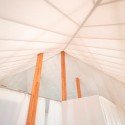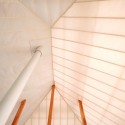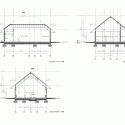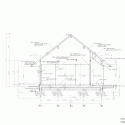Tuesday, July 09. 2013
Redesigned Window Stops Sound But Not Air, Say Materials Scientists
-----
By exploiting some exotic acoustic techniques, researchers have built a window that allows the passage of air but not sound
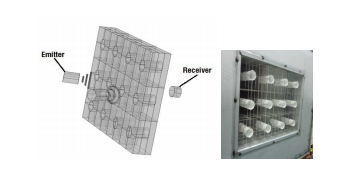
Noise pollution is one of the bugbears of modern life. The sound of machinery, engines, neighbours and the like can seriously affect our quality of life and that of the other creatures that share this planet.
But insulating against sound is a difficult and expensive business. Soundproofing generally works on the principle of transferring sound from the air into another medium which absorbs and attenuates it.
So the notion of creating a barrier that absorbs sound while allowing the free of passage of air seems, at first thought, entirely impossible. But that’s exactly what Sang-Hoon Kima at the Mokpo National Maritime University in South Korea and Seong-Hyun Lee at the Korea Institute of Machinery and Materials, have achieved.
These guys have come up with a way to separate sound from the air in which it travels and then to attenuate it. This has allowed them to build a window that allows air to flow but not sound.
The design is relatively simple and relies on two exotic acoustic phenomenon. The first is to create a material with a negative bulk modulus.
A material’s bulk modulus is essentially its resistance to compression and this is an important factor in determining the speed at which sound moves through it. A material with a negative bulk modulus exponentially attenuates any sound passing through it.
However, it’s hard to imagine a solid material having a negative bulk modulus, which is where a bit of clever design comes in handy.
Kima and Lee’s idea is to design a sound resonance chamber in which the resonant forces oppose any compression. With careful design, this leads to a negative bulk modulus for a certain range of frequencies.
Their resonance chamber is actually very simple—it consists of two parallel plates of transparent acrylic plastic about 150 millimetres square and separated by 40 millimetres, rather like a section of double-glazing about the size of a paperback book.
This chamber is designed to ensure that any sound resonating inside it acts against the way the same sound compresses the chamber. When this happens the bulk modulus of the entire chamber is negative.
An important factor in this is how efficiently the sound can get into the chamber and here Kima and Lee have another trick. To maximise this efficiency, they drill a 50 millimetre hole through each piece of acrylic. This acts as a diffraction element causing any sound that hits the chamber to diffract strongly into it.
The result is a double-glazed window with a negative bulk modulus that strongly attenuates the sound hitting it.
Kima and Lee use their double-glazing unit as a building block to create larger windows. In tests with a 3x4x3 “wall” of building blocks, they say their window reduces sound levels by 20-35 decibels over a sound range of 700 Hz to 2,200 Hz. That’s a significant reduction.
And by using extra building blocks with smaller holes, they can extend this range to cover lower frequencies.
What’s handy about these windows is that holes through them also allow the free flow of air, giving ample ventilation as well.
The applications are many. Changing the size of the holes makes the windows tunable so they screen out only certain frequencies, the new designs have some interesting applications.
“For example, if we are in a combined area of sounds from sea waves of low frequency and noises from machine operating at a high frequency, we can hear only the sounds from sea waves with fresh air,” say Kima and Lee.
What’s more, they say the same idea should also work in water which could help in applications such as protecting marine animals from noise pollution.
A clever idea that tackles one of the increasingly common problems of modern living.
Ref: arxiv.org/abs/1307.0301: Air Transparent Soundproof Window.
Wednesday, June 05. 2013
Silk Pavillion – CNC Deposited Silk & Silkworm Construction at the MIT Media Lab
-----

Created at the Mediated Matter Research Group at the MIT Media Lab, The Silk Pavilion explores the relationship between digital and biological fabrication on product and architectural scales. The primary structure was created of 26 polygonal panels made of silk threads laid down by a CNC (Computer-Numerically Controlled) machine, followed by a swarm of 6,500 silkworms spinning flat non-woven silk patches as they locally reinforced the gaps across CNC-deposited silk fibers.
Inspired by the silkworm’s ability to generate a 3D cocoon out of a single multi-property silk thread (1km in length), the overall geometry of the pavilion was created using an algorithm that assigns a single continuous thread across patches providing various degrees of density. Overall density variation was informed by the silkworm itself deployed as a biological “printer” in the creation of a secondary structure.


More about it HERE.
Tuesday, March 12. 2013
Chinese Physicists Build “Ghost” Cloaking Device
-----
A working invisibility cloak that makes one object look like ghostly versions of another has been built in China.

Illusion cloaks that make one object look like another are a fascinating type of invisibility device. The general idea is that such a device would make an apple look like a banana or a fighter plane look like an airliner. Clearly this would have important applications.
But while materials scientists have made great strides in building ordinary invisibility cloaks that work in the microwave, infrared and optical parts of the spectrum, making illusion cloaks is much harder. That’s because the bespoke materials they rely on require manufacturing techniques that seem like a distant dream.
Today, Tie Jun Cui and buddies at Southeast University in Nanjing, China, say they’ve designed and built a practical alternative to illusion cloaks, which they call a “ghost cloak”.
Conventional illusion cloaks rely on a two stage process. The first is a kind of invisibility stage which distorts incoming light to remove the scattering effect of the cloaked object, an apple for example. The second stage then distorts the scattered light to make it look as if it has been scattered off another object, a banana, for example. The result is that the apple ends up looking like a banana.
But materials that can perform this two-stage process are too demanding to make with current techniques.
So Tie Jun Cui and co have developed a single stage process that achieves a slightly different effect. Their idea is to do away with the first stage that makes the apple invisible.
Instead, their device takes the light scattered from the apple and distorts it to look like something else such as a banana. The symmetry of the effect–light is scattered on both sides of the apple–mean that this approach produces two “ghost” bananas, one on each side of the apple. The technique does not remove the apple entirely but distorts it, making it appear much smaller.
So the result is that the apple is changed into a much more complex picture that is significantly different from the original.
The big advantage of this approach is that it can be achieved now with existing technology. Tie Jun Cui and co first simulate the effect of their ghost cloak on a computer model.
They then go on to build a working prototype using concentric cylinders of split ring resonators that operates in 2 dimensions. They say that the results of their tests on this device closely match the results of the simulation.
That’s an interesting advance. The ability to distort and camouflage objects is clearly useful. However, an important question is whether the distortion that this device offers is good enough for any practical applications. Tie Jun Cui and co mention “security enhancement” but just how effective this would be when the original object is still visible, albeit in shrunken form, is debatable.
It may be that there are ways of improving the performance so it’ll be interesting to see what this team comes out with next.
Ref: arxiv.org/abs/1301.3710: Creation of Ghost Illusions Using Metamaterials in Wave Dynamics
Related Links:
Thursday, February 14. 2013
First Toy Multiverse Created in a Laboratory, Say Physicists
MIT Technology Review
-----
Researchers exploit the strange properties of a liquid metamaterial to watch Minkowski spacetimes leap in out and of existence.
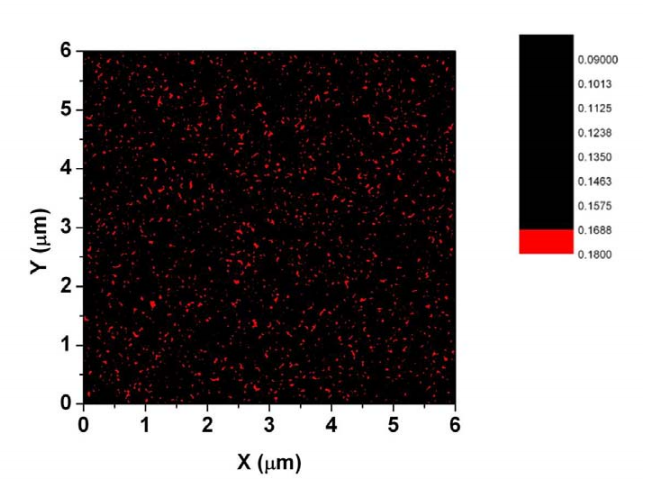
Metamaterials are synthetic substances with nanoscale structures that manipulate light. This ability to steer photons makes them the enabling technology behind invisibility cloaks and has generated intense interest from researchers.
The ability to guide light has more profound consequences, however. Various theoreticians have pointed out that there is a formal mathematical analogy between the way certain metamaterials bend light and the way spacetime does the same thing in general relativity. In fact, it ought to be possible to make metamaterials that mimic the behaviour of not only our own spacetime but also many others that cosmologist merely dream about.
Indeed, a couple of years ago we looked at a suggestion by Igor Smolyaninov at the University of Maryland in College Park that it ought to be possible to use metamaterials to create a multiverse in which different regions of the material corresponded to universes with different properties.
Today, Smolyaninov and a couple of buddies announce the extraordinary news that they have done exactly this. They’ve created a metamaterial containing many “universes” that are mathematically analogous to our own, albeit in the three dimensions rather than four.
“These regions behave as transient 2+1 dimensional Minkowski spacetimes which temporarily appear and disappear inside a larger metamaterial “multiverse”,” they say.
The experiment is relatively straightforward. Metamaterials are usually hard to engineer because they are based on nanoscale structures. However, Smolyaninov and pals have instead exploited the self-assembling nature of cobalt nanoparticles suspended in kerosene.
Cobalt is ferromagnetic so the nanoparticles tend to become aligned in a magnetic field. In fact, if the density of nanoparticles is high enough, the field causes them to line up in columns. When this happens, the nanocolumns form a metamaterial which is mathematically equivalent to a 2+1 Minkowski spacetime.
So light passing through behaves as if this region has one dimension of time, aligned with the nanocolumns, and two dimensions of space, perpendicular to the nanocolumns.
That creates a single Minkowski universe. The trick that Smolyaninov and pals have pulled off is to create a multiverse containing many Minkowski spacetimes .
The secret here is to keep the density of nanoparticles just below the threshold required to form nanocolums. That’s just over 8 per cent of the fluid by volume in this case. When that happens, natural variations in the density cause nanocolumns to form in small regions of the liquid. In effect, tiny universes are leaping in and out of existence. Smolyaninov and co can even “see” these universes by their effect on polarised light passing through the fluid.
That’s a fascinating result that demonstrates the potential of self-organisation to create metamaterials.
Smolyaninov has also suggested in the past that this kind work might give physicists a way to study new kinds of optical devices since photons can be made to behave like massive or massless particles, depending on the properties of their “universe”.
Clearly there’s more fun to be had here.
Ref: arxiv.org/abs/1301.6055: Experimental Demonstration Of Metamaterial “Multiverse” In A Ferrofluid.
Related Links:
Personal comment:
Again, some fascinating spatial and perceptual properties coming out from research in metamaterials. Even so it happens at nanoscales.
Thursday, January 24. 2013
Même – Experimental House / Kengo Kuma & Associates

Architects: Kengo Kuma & Associates
Location: Hokkaido Prefecture, Hiroo District, Taiki, Memu, Japan
Project Architect: Kengo Kuma, Takumi Saikawa
Client: LXIL JS Foundation
Structural Engineering: Yashushi Moribe (Showa Womden’s University)
Area: 79,5 sqm
Year: 2011
Photographs: Courtesy of Kengo Kuma & Associates





We were in charge of the first experimental house, and in the process of designing, we got a number of clues from “Chise,” the traditional housing style of the Ainu. What is most characteristic about Chise is that it is a “house of grass” and “house of the earth.” While in Honshu (the main island) a private house is principally a “house in wood” or “house of earthen wall,” Chise is distinctively a “house of grass,” as the roof and the wall are entirely covered with sedge or bamboo grass so that it can secure heat-insulating properties. Also, in Honshu the floor is raised for ventilation to keep away humidity, whereas in Chise they spread cattail mat directly on the ground, make a fireplace in the center, and never let the fire go out throughout the year. The fundamental idea of Chise, “house of the earth,” is to keep warming up the ground this way and retrieve the radiation heat generated from it.

Here is how section of the house is structured: We wrapped a wooden frame made of Japanese larch with a membrane material of polyester fluorocarbon coating. Inner part is covered with removable glass-fiber-cloth membrane. Between the two membranes, a polyester insulator recycled from PET bottles is inserted that penetrates the light. This composition is based on the idea that by convecting the air in-between, the internal environment could be kept comfortable because of the circulation.

We do not treat insulation within the thickness of heat-insulation material only, which was a typical attitude of the static environmental engineering in 20th century. What we aim at is a dynamic environmental engineering to replace it for this age. That we utilize the radiant heat from the floor is part of it, and it has been verified that you could spend several days in winter here without using floor heating. The other reason we covered the house with membrane material was our longing for a life surrounded by natural light, as if you were wrapped in daylight on the grassland. Without relying on any lighting system, you simply get up when it gets light, and sleep after dark – we expect this membrane house enables you to lead a life that synchronizes the rhythm of the nature.

In one part of the house, a wooden insulated window sash is installed external to the membrane. It is a new device to monitor the living environment of the house by changing various types of sashes. Likewise, all glass fiber cloth in the interior can be removed so that we can continue many kinds of environmental experiment.

Related Links:
Personal comment:
Very interested in the experimental materiality of this house, its semi-transparent roof, isolation and coating. Makes me think of the "ghost appartements" made out of nylon by the korean artist Do-ho Suh, only this one is inhabitable.
Tuesday, November 20. 2012
All-Carbon Solar Cells Will Mean Cheap and Flexible Solar Panels
-----
Flexible photovoltaics made of carbon promise low cost and durability, if their performance can be improved.
By Katherine Bourzac on November 15, 2012

Carbon cell: The all-carbon solar cell consists of a photoactive layer between two electrodes.
Using a grab bag of novel nanomaterials, researchers at Stanford University have built the first all-carbon solar cells. Their carbon photovoltaics don’t produce much electricity, but as the technology is perfected, all-carbon cells could be inexpensive, printable, flexible, and tough enough to withstand extreme environments and weather.
The goal is not to replace solar cells made from silicon and other inorganic materials, says Zhenan Bao, professor of chemical engineering at Stanford University, who led the work. Rather, it is to fill new niches. “Carbon is one of the most abundant elements on earth, and it is versatile,” Bao says.
Thanks to its versatility, carbon in one form or another was used to make each solar-cell component. The three main parts—a nanotube cathode and a graphene anode sandwiching an active layer made of nanotubes and buckyballs—were all made by printing or evaporating from inks.
Making the cathode work was the trickiest part, says Bao—researchers have had a hard time making carbon nanomaterials that collect electrons. The Stanford researchers solved the problem by picking the right flavor of nanotubes and giving them a chemical treatment. This work is described in the journal ACS Nano.
The all-carbon photovoltaics convert less than 1 percent of the energy in light into electricity (by comparison, a silicon solar cell converts around 20 percent of light into electricity). However, Bao says that her group worked mostly with off-the-shelf materials, with just a bit of tuning. She attributes part of the problem to the roughness of the carbon films, which trips up traveling charges, and says it should be possible to smooth them out by working on the processing methods.
Carbon nanomaterials “are still relatively new materials,” says Bao. “There’s a lot of research on how to control their properties and how to use them.”
IBM Yorktown researcher and 2011 MIT Technology Review young innovator Fengnian Xia, who is not involved in the work, agrees, saying that the solar cells need better-quality starting materials and processes. “The idea is great, and this is a good first demonstration, but it’s not ready for realistic applications,” he says.
Other groups are focused on making better carbon materials for the active layers of photovoltaics. According to theoretical calculations by Jeffrey Grossman at MIT, carbon solar cells should be able to reach 13 percent conversion efficiency.
For carbon solar cells to be commercially viable, says Shenqiang Ren, assistant professor of chemistry at the University of Kansas, their efficiency must cross 10 percent. Ren’s lab set the conversion-efficiency record for carbon solar cells (equipped with conventional metal electrodes) at 1.3 percent this September, in work that appeared in ACS Nano. That’s about how well the first polymer solar cells performed, he notes.
Ren is working with computational materials scientists, including Grossman, to design better carbon photovoltaics by picking the right kinds of carbon nanomaterials. With this guidance, Ren says, his lab has already made carbon solar cells that convert 5 percent of light energy into electricity, and he expects to go higher still.
Monday, November 05. 2012
Piezoelectric Energy-Generating “Scene Sensor” Wins the 2012 Land Art Generator Initiative Competition for Freshkills Park
The Land Art Generator Initiative just announced the winner of its 2012 design competition moments ago in New York City. "Scene Sensor", designed by artists James Murray and Shota Vashakmadze, is a striking piezoelectric energy-generating art project designed to be installed above and below the surface of the Staten Island park. — Inhabitat NYC
Related Links:
Friday, October 19. 2012
Self-Assembling Structures, Rippling Computational Walls, And The Experimental Architecture (Of The Future)
-----
MIT Architecture from Paper Fortress on Vimeo.
What will buildings of the future look like and how will they be built? Will they feature dynamic materials that communicate information? How about buildings that can assemble themselves? Or feature rippling computational walls controlled by a smartphone? Or will we, finally, be living on the moon? It’s food for thought and the sort of people who are having debates like that for breakfast are found at places like MIT Architecture.
(...)
Related Links:
Wednesday, May 30. 2012
Graffiti as Tactical Urban Wireless Network
Via Pruned
-----

A Utah-based startup company called Chamtech Operations is claiming that its Spray On Antenna Kit can turn any surface into a high-powered antenna.
As explained by Anthony Sutera in the video below of his presentation at Google's Solve for X event, “Our material uses thousands of nano-capacitors that we can spray paint on in the right pattern. All of these little capacitors charge and discharge extremely quickly in real time and they don't create any heat. When we hook up our material to a radio, the signal hops from capacitor to capacitor very quickly, finds its happy spot, and launches into space.”
Imagine painting wireless antennas on walls. Instead of planting them as fake trees or simply uncamouflaged, phone companies will blend their unsightly cell towers into the landscape. They could even commission artists like Haas & Hahn to turn the city as though fully draped with Joseph's Amazing Technicolor Dreamcoat.

Alternatively, they could enlist children from local elementary schools to reconfigure the city's electromagnetic infrascape in exchange for very plump donations. Is that mural on that once seamy but now chromatically resplendent underpass depicting the neighborhood's tempestuous history and encouraging future, their parents will ask. Why yes, they'll answer back, and you can also bounce phone calls off of it.

Elsewhere, graffiti artists will independently fill in the dead zones. Or maybe not to patch up the network, but rather as part of a collaboration with sound artists to create a pop-up pirate radio station to broadcast an improvisational audio documentary of the local area. During times of protest, they could be used to burst through whatever electromagnetic kettling the security forces might be using to prevent the crowds from organizing and reaching critical mass. If there's no graffiti antenna nearby, just whip out a Spray On Antenna Kit to reclaim the public spectrum.
In any case, I'd like those “nut jobs” at DEMILIT given some of the stuff and see how they might use it in one of their sonic tours of military landscapes. Will they spray it on crumbling bunkers and derelict silos, thus repurposing them into antennas to transmit in real-time the acoustic ecology of war?
What might avant-gardeners, who presumably already know how to harness energy from trees, do with the stuff if they find out that you can also apply them to trees and turn them into arboreal arrays?


Trees broadcasting themselves singing. An entire national park airing an epic botanical opera. The Amazon sending messages to exoplanets.
Wednesday, May 02. 2012
MIT creates invisible glass that's fog+glare free and self cleaning

One of the most instantly recognizable features of glass is the way it reflects light. But a new way of creating surface textures on glass, developed by researchers at MIT, virtually eliminates reflections, producing glass that is almost unrecognizable because of its absence of glare — and whose surface causes water droplets to bounce right off, like tiny rubber balls.
Personal comment:
Invisible glass, invisible cloacks, darker than black black, etc. : a whole range of new (meta)materials are around the corner.
fabric | rblg
This blog is the survey website of fabric | ch - studio for architecture, interaction and research.
We curate and reblog articles, researches, writings, exhibitions and projects that we notice and find interesting during our everyday practice and readings.
Most articles concern the intertwined fields of architecture, territory, art, interaction design, thinking and science. From time to time, we also publish documentation about our own work and research, immersed among these related resources and inspirations.
This website is used by fabric | ch as archive, references and resources. It is shared with all those interested in the same topics as we are, in the hope that they will also find valuable references and content in it.
Quicksearch
Categories
Calendar
|
|
July '25 | |||||
| Mon | Tue | Wed | Thu | Fri | Sat | Sun |
| 1 | 2 | 3 | 4 | 5 | 6 | |
| 7 | 8 | 9 | 10 | 11 | 12 | 13 |
| 14 | 15 | 16 | 17 | 18 | 19 | 20 |
| 21 | 22 | 23 | 24 | 25 | 26 | 27 |
| 28 | 29 | 30 | 31 | |||

























